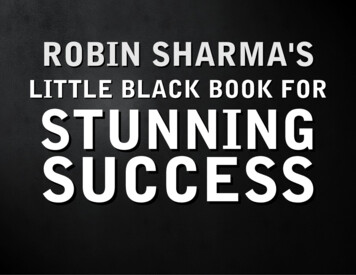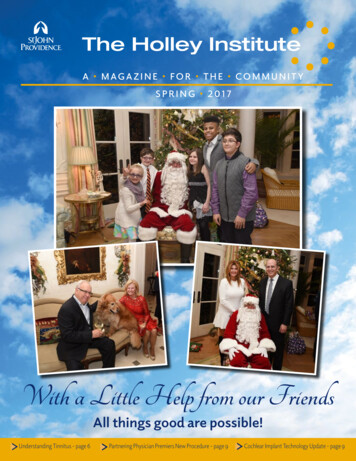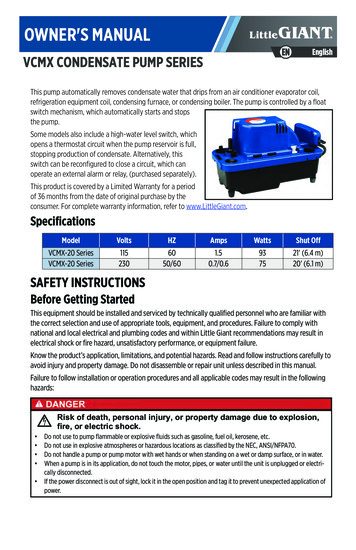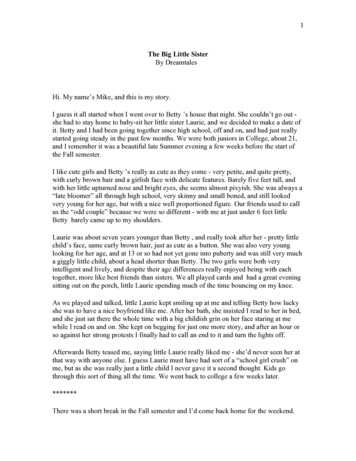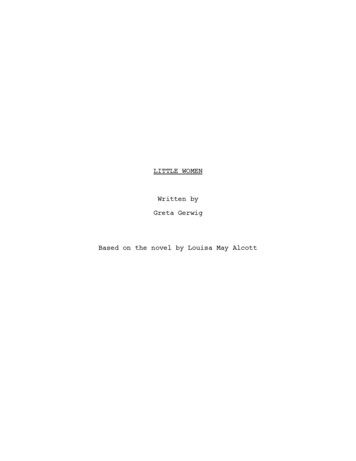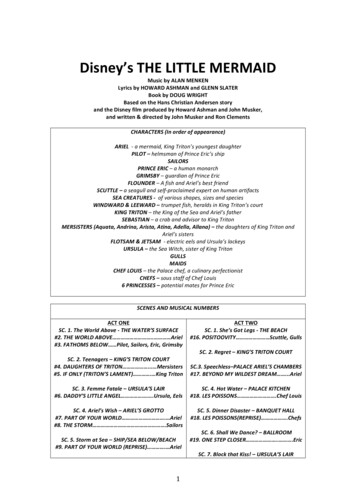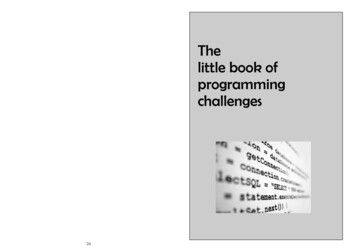
Transcription
Thelittle book ofprogrammingchallenges24
The following challenges are here to challenge and inspire you aswell as help you on your journey to becoming a ‘computationalthinker’.Challenge 26CodeBreakerYou may be set these as homework or in the classroom. Try to complete them to the best of your ability. If you can’t write a successfulsolution don't worry, you are still learning from the attempt youhave made.The computer generates a 4 digit codeThe user types in a 4 digit code. Their guess.The computer tells them how many digits they guessed correctlyTry to complete the extension exercises too whenever possible—extension doesn't mean ‘optional’!Extension : the computer tells them how many digits areguessed correctly in the correct place and how many digits havebeen guessed correctly but in the wrong place.Writing programs can be frustrating - if you get stuck don't giveup!The user gets 12 guesses to either win – guess the right code. Orlose – run out of guesses. Use the internet for help (but not the answer!)Use the help features of the programming development environment.Use features like break points and variable watches to try towork out what is happening if the program doesn’t seem towork.Work with other students on the course—’two heads are better than one’Challenge 27HangManPlayer 1 types in a wordPlayer 2 has to guess the word in 5 livesThe display would look like thisWord to guess: ******You have 5 lives left - Letter? EWord to guess: **EE*EYou have 5 lives left - Letter? ZWord to guess: **EE*EYou have 4 lives left - Letter?223
Challenge 25Remember Challenge 9?Write a program that will generate a randomplaying card e.g. ‘9 Hearts’, ‘Queen Spades’when the return key is pressed.Rather than generate a random number from 1to 52. Create two random numbers – one for thesuit and one for the card.Challenge 1However we don't want the same card drawn twice. Update thisprogram by using an array to prevent the same card being dealttwice from the pack of cards.Extensiondisplay the punchline in a different colourWrite a program that will display a jokeDon’t display the punchline until the readerhits the enter key.Convert this code into a procedure ‘DealCard’ that will display thecard dealt or ‘no more cards’.Prior Knowledge NeededHow to output information to the screenCall your procedure 53 times!Challenge 25 ExtendedBlackjack.Challenge 2Play a game that draws two random cards (see above).The player then decides to draw or stick.Write a program that will ask you your nameIf the score goes over 21 the player loses (goes ‘bust’).Keep drawing until the player sticks.After the player sticks draw two computer cards. If the playerbeats the score they win.Added complication : Aces can be 1 or 11! The number used iswhichever gets the highest score.It will then display ‘Hello Name’ where ‘Name’ is thename you have entered.E.g.What is your name?AdaHello AdaPrior Knowledge NeededHow to create variablesHow to input data into a variableHow to display variables223
Challenge 3Challenge 24Create a program with the following record structureWrite a program to work out the areas of a rectangle.Collect the width and height of the rectangle from the keyboardStructure ResultsHomeTeam as stringHomeTeamScore as integerAwayTeam as stringAwayTeamScore as integerEnd StructureCalculate the areaMake an array of 20 Resultsdisplay the result.Create a program with a menu whose options are1.Add a result2. Search for all results for a teamExtensiondisplay the volume of a cuboid.Prior Knowledge NeededSee what happens when youdon't type in numbers! - Tryto explain what has happened and whyHow to create variablesHow to input data into a variableHow to display variablesHow to perform basic mathematicalcalculationsWrite the code to carry out these two things.If option 1 is selected collect the result and add it to the end of the results arrayIf option 2 is selectedCollect team namedisplay all the results that in includes that team in either thehome or away team Challenge 4Write a program that will work out thedistance travelled if the user enters in thespeed and the time.ExtensionGet the program to tell you the speed you would have to travelat in order to go a distance within a certain time entered by theuser.HintInclude a variable to store the current number of resultsPrior Knowledge NeededHow to create record structuresCreating arrays of record structuresIteration and selection421
Challenge 22Create a two-dimensional array of integers 10 by 10.Challenge 5Fill the array with random numbers in the range 0 to 15Write a program to work out how many days you have lived for.Display the array on the screen showing the numbersAgorithmDisplay the array on the screen as spaces whose BackColor property has been set to the number in this position of the array.Prior Knowledge NeededHow to create 2D arraysUsing nested loopsEnter date of birthGet today’s dateGet the difference in days between the two datesDisplay resultExtensionChallenge 23Create a simple treasure hunt game.Create a two-dimensional array of integers 10 by 10.In a random position in the array store the number 1.repeatWork out how many seconds you’ve lived for.HintsUse Date.Now to get today’s dateUse the date type for a variable to store your date of birthUse the datediff function to get the difference between two daysGet the user to enter coordinates where they think the treasure is.If there is a 1 at this position display ‘success’.Until they find the treasurePrior Knowledge NeededExtensionHow to create variablesHow to input data into a variableHow to display variablesHow to use system functions.How to use system variablesAdd a feature to say ‘hot’ ‘cold’‘warm’ depending on how closetheir guess was to the actual hidden location.20Prior Knowledge NeededHow to create 2D arrays5
Challenge 6Challenge 21Write a program that will store names into an array.Make a game for seeing how good people are atguessing when 10 seconds have elapsed.As a new name is entered it will be added to the end of the array.The user can keep adding names until they enter the dummyvalue ‘exit’Once this has been done the program will display any duplicatenames.AlgorithmTell them to hit enter key when readyE.g.Get the first time in secondsEnter name: BillGet them to hit the enter key when they thinktime has elapsedEnter name: MaryGet the second time in secondsEnter name: AnishaSubtract first time from the second timeEnter name: MaryTell them how close to 10 the answer was.Enter name: exitMary is a duplicate.HintExtensionUse Now.Second - To get the current time in seconds of the minuteDisplay how many times each name has been duplicatedExtensionPrior Knowledge NeededSometimes this solution doesn'twork. Can you work out why itdoesn’t work? Can you fix it?How to create variablesHow to input data into a variableHow to display variablesHow to use system functions.How to use system variables6Prior Knowledge NeededHow to create a Nested FORloop structure.Using arrays19
Challenge 20Create a Fibonacci sequence generator. (The Fibo-Challenge 7quence goes like this.Extend the program in Challenge 5 to make agame for seeing how quick people are at typing the alphabet.nacci sequence was originally used as a basic modelfor rabbit population growth). The Fibonacci se0,1,1,2,3,5,8,13The Nth term is the sum of the previous two terms. So in theexample above the next term would be 21 because it would be theprevious two terms added together (8 13).You will need create a list of Fibonnaci numbers up to the 50thterm.The program will then ask the user for which position in the sequence they want to know the Fibonacci value for (up to 50).E.gAlgorithmTell them to hit enter key when readyGet the first time in seconds (and minutes)Get them to type in the alphabet and hit enterGet the second time in seconds (and minutes)Check they have entered the alphabet correctly(start counting at 0)Which position in sequence? 6If they entered it correctly thenFibonacci number is 8Subtract first time from the second timeTell them how many seconds they tookHintYou will need to store the sequence in an array of Long (thesenumbers can get pretty big!)Prior Knowledge NeededHow to create a FOR loop structure.Using arrays18HintYou’ll need to store their attempt at the alphabet in a variable andcompare with “abcdef.”ExtensionPrior Knowledge NeededKeep a record of the best timeachieved.As challenge 5 plus.How to write an IF statement.Deal with upper or lower case letters entered7
Challenge 8Write a program that will accept someone’s date of birth andwork out whether they can vote (i.e. Are they 18?)Prior Knowledge NeededHow to create IF statement.Using the dateDiff functionChallenge 19 Continued.The Ceaser algorithms may have fooled the Gauls but it doesn'ttake a genius to crack. So a much better algorithm would be onethat has a different offset for every letter. We can do this using therandom number generator—because it generates the same sequence of random numbers from a ‘seed’ position. As long assender and receiver agree where to ‘seed’ (this will be the encryption key) they can both work out the same offsets.Algorithm for encrypt functionfunction Encrypt(text, key)Randomize(key)Challenge 9For each letter in textWrite a program that will generate arandom playing card e.g. ‘9 Hearts’,‘Queen Spades’ when the return key ispressed.Rather than generate a random numberfrom 1 to 52. Create two random numbers – one for the suit and one for thecard.Get its ascii codeAdd random offset int(rnd()*10) to ascii codeTurn this new ascii code back to a characterAppend character to ciphertext stringEnd forreturn ciphertextExtensionendMake a loop structure so playing cards can keep being generatedPrior Knowledge NeededHow to create IF or CASE statements with logical operators .How to generate random numbers8Prior Knowledge NeededHow to create IF statements.ExtensionTry to use a single function withan extra parameter to indicatewhether the text is being encrypted or decrypted rather thanhaving two different functions.17How to create a condition controlled loop structure.Using procedures and functionsString manipulation
Challenge 19Write a program to perform a basic ‘Ceaser’ encryption and decryption on text.Challenge 10Make a game of rock, paper scissors against thecomputer.This algorithm works by moving letters along by an‘offset’. If the offset is 2 then b — d, h— j etc.Try to write two functions—One called ‘encrypt’ and one called’decrypt’. Both will return a string.The user selects whether the wish to encrypt or decrypt.The user enters sentence to encrypt and the encryption key (i.e.How many we move the letters along—this is a smallish integer)The program responds with the encrypted or decrypted versionAlgorithmTell user to enter either rock,paper or scissorsGet the responseGenerate a random number from 1 to 33 scissors)(1 rock,2 paper,Compare user selection and computer selectionDisplay who wins.Algorithm for encryptionHintsTo get a single characterfrom a string of charactersjust add position in bracketsafter string name.Text “Hello”Text(0) “H”Type in textType in encryption keyDisplay Encrypt(text, key)function Encrypt(text,key)Len(Text) or Text.lengthwill give you the number ofcharacters in string.For each letter in textGet its ascii codeAdd the key to the ascii codeHintDon’t forget to randomize!ExtensionMake sure the user enters a valid entry.Add a loop structure to play several times and keep a runningscoreMake an enumerated variable type to store choices.Turn this new ascii code back to a characterPrior Knowledge NeededAppend character to ciphertext stringHow to create IF statements withlogical operators (or nested Ifs)End forreturn ciphertextHow to generate random numbersend169
Challenge 11Write a program that will give thestudents the answer to logic gatequestions e.g.Challenge 18Write a procedure(sub) drawstars that will draw a sequence ofspaces followed by a sequence of stars. It should accept two parameters—the number of spaces and the number of stars.E.gEnter logic gate : ORDrawstars(3,5) would produceEnter first input : 1*****( indicates a space!)Enter second input :0Result 1Use your procedure to drawIt should work for the logic gates OR, AND and XORPrior Knowledge NeededHow to create IF statementsusing logical operatorsExtensionInclude NAND and NOR gates**********Challenge 12Write a program that will display all the factors of a number, entered by the user, that are bigger than 1.(e.g. the factors of the number 12 are 6,4,3 and 2 because they divide into 12 exactly).Prior Knowledge NeededHow to create proceduresHow to use parameters*********** *** **HintExtensionto find out whether a number X is a factor of Y use :Now write a program using this procedure that will draw a pyramid whose base is a width specified by the user. E.g.IF Y mod X 0 (there is nothing remaining when Y is divided by X)Enter base size of pyramid : 5ExtensionTell the user if the number theyentered is a prime numberPrior Knowledge NeededHow to create IF statementsHow to create a loop structure10*********(assume the user has to enter an odd number)15
Challenge 17Write a function that will convert a UMS score into a grade. Thefunction will return ‘A’— ‘U’.The function will require a parameter to do its job: the markThe formula for AS level is 80% — ‘A’, 70%— ‘B’, 60%— ‘C’etc.Assume the maximum module mark is 100Having written the function we want to use it three times.Write a program with the function that allows the user to entertwo module AS scores and displays the grade. It then adds the tworesults together and displays the students overall grade. E.g.Challenge 13Write a program for a game where the computer generates arandom starting number between 20 and 30.The player and the computer can remove 1,2 or 3 from the number in turns. Something like this.Starting number : 25How many do you want to remove? 322 leftComputer removes 220 leftEnter Module 1 result: 78Enter Module 1 result: 67The player who has to remove the last value to bring the numberdown to 0 is the loser.Result1 leftModule 1 : BComputer removes 1Module 2: CYou win!AS Level : BEasy optionGet the computer to choose a number between 1—3 at randomExtensionAllow a maximum mark other than 100. This will require the userto enter both the mark and maximum possible for that module.The function will also require the maximum mark in order to calculate the grade so another parameter will be needed.Harder optionGet the computer to employ a strategy to try and winPrior Knowledge NeededHow to generate random numbers.How to create IF statementsPrior Knowledge NeededHow to create functionsHow to use parametersHow to create a loop structure1411
Challenge 14Write a program for a Higher / Lower guessing gameChallenge 15Write a program to count the number of words in a sentence.The computer randomly generates a sequence of up to 10 numbers between 1 and 13. The player each after seeing each numberin turn has to decide whether the next number is higher or lower.If you can remember Brucie’s ‘Play your cards right’ it’s basicallythat. If you get 10 guesses right you win the game.The user enters a sentence.The program responds with the number of words in the sentence.HintLook for spaces and full stops in the string.Starting number : 12Higher(H) or lower(L)? LExtensionNext number 8Develop a program that willdisplay a sentence backwardsafter entered.Higher(H) or lower(L)? LNext number 11You losePrior Knowledge NeededHow to use string manipulation functionsUsing loops and selectionChallenge 16Guess the number game.HintsUse a condition controlled loop (do until, while etc) to control thegame. Do not find yourself repeating the same code over andover!The computer selects a random number between 1 and 100.You don't need to remember all 10 numbers just the current number /next number. Don’t forget you’ll have to keep a count of thenumber of turns they’ve had.The computer responds ‘got it’ or ‘too high’ or ‘too low’ after eachguess.ExtensionsAfter the user has guessed the number the computer tells themhow many attempts they have made.Give the players two livesMake sure only H or L canbe enteredPrior Knowledge NeededHow to create IF statements.How to create a condition controlledloop structure.12The user keeps guessing which number the computer has chosenuntil they get it right.Extension- Reverse the game. You think of a number. Get thecomputer to guess a number and you respond with too high(H),too low(L) or got it(G). Make sure the computer has a gameplan—don't just let it guess at random!13
Create a Fibonacci sequence generator. (The Fibo-nacci sequence was originally used as a basic model for rabbit population growth). The Fibonacci se-quence goes like this. 0,1,1,2,3,5,8,13 The Nth term is the sum of the previous two terms. So in the exampl

